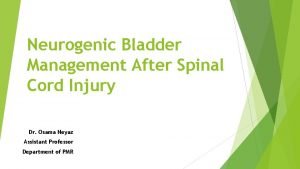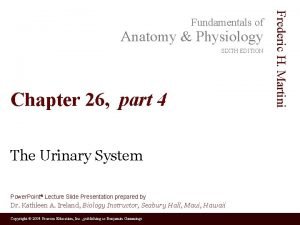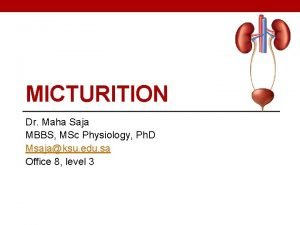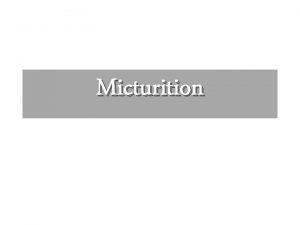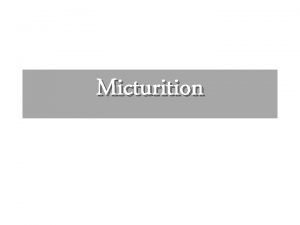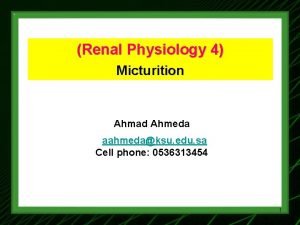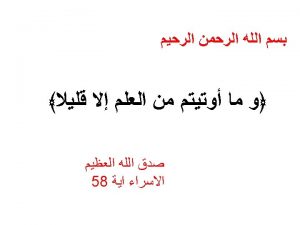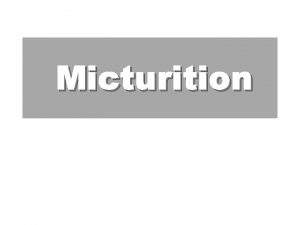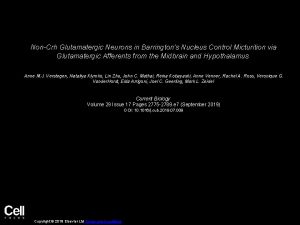Physiology of Micturition DR RASHMI Defination of Mituration


















- Slides: 18

Physiology of Micturition DR RASHMI

Defination of Mituration: - Ø Micturition is a process by which urine is voided out from the urinary bladder. ØIt is a reflex process. ØThe functional anatomy and nerve supply of urinary bladder are essential for the process of micturition.

PHYSIOLOGICAL ANATOMY OF URINARY BLADDER ØUrinary bladder is mainly a smooth muscle hollow vesicle. ØIt is composed of following – 1. The Body: -which is comprised of Detrusor muscle. It is mainly responsible for emptying of the bladder during micturition 2. The Trigone: - – A small triangular area near the mouth of UB, through which both ureters and urethra pass. 3. The Internal sphincter: -The trigonal muscle fibers get interlaced around the opening of urethra forming internal sphincter. Its main function is to maintain tonic closure of the urethral opening

4. The External sphincter: - It is a voluntary skeletal muscle. It can be reflexly or voluntary relaxed at the time of micturition. The physiological capacity of UB in adults is 600 ml.

NERVE SUPPLY TO URINARY BLADDER AND SPHINCTERS ØUrinary bladder and the internal sphincter are supplied by I. Sympathetic and II. Parasympathetic divisions of ANS ØThe external sphincter is supplied by the somatic nerve fibers

Features Of Nerve Supply Of The Urinary Bladder

Nerve supply to urinary bladder and urethra

FILLING OF URINARY BLADDER �PROCESS OF FILLING: - ØUrine is continuously formed by nephrons and it flows into urinary bladder drop by drop through ureters. ØWhen urine collects in the pelvis of ureter, the contraction sets up in pelvis. ØThis contraction is transmitted through rest of the ureter in the form of peristaltic wave up to trigone of the urinary bladder. ØAfter leaving the kidney, the direction of the ureter is initially downward and outward. ØThen, it turns horizontally before entering the bladder.

ØAt the entrance of ureters into urinary bladder, a valvular arrangement is present. ØWhen peristaltic wave pushes the urine towards bladder, this valve opens towards the bladder. ØThe position of ureter and the valvular arrangement at the end of ureter prevent the back flow of urine from bladder into the ureter when the detrusor muscle contracts. ØThus, urine is collected in bladder drop by drop. ØA reasonable volume of urine can be stored in urinary bladder without any discomfort and without much increase in pressure inside the bladder.

CYSTOMETROGRAM Definition: - ØCystometry is the technique used to study the relationship between intravesical pressure and volume of urine in the bladder. ØCystometrogram is the graphical registration (recording) of pressure changes in urinary bladder in relation to volume of urine collected in it.

Cystometrogram. Dotted lines indicate the contraction of detrusor muscle.

Components of Cytometrogram are called segments: Segment I ØInitially, when the urinary bladder is empty, the intravesical pressure is 0. ØWhen about 100 m. L of fluid is collected, the pressure rises sharply to about 10 cm H 2 O. Segment II ØSegment II shows the plateau, i. e. no change in intra vesical pressure. ØIt remains at 10 cm H 2 O even after introducing 300 to 400 m. L of fluid. It is because of adaptation of urinary bladder by relaxation

Segment III ØAs the pressure increases with collection of 300 to 400 m. L of fluid, the contraction of detrusor muscle becomes intense, increasing the consciousness and the urge for micturition. ØStill, voluntary control is possible up to volume of 600 to 700 m. L at which the pressure rises to about 35 to 40 cm H 2 O. ØWhen the intravesical pressure rises above 40 cm water, the contraction of detrusor muscle becomes still more intense. ØAnd, voluntary control of micturition is not possible. ØNow, pain sensation develops and micturition is a must at this stage.

MICTURITION REFLEX Ø Micturition reflex is the reflex by which micturition occurs. Ø This reflex is elicited by the stimulation of stretch receptors situated on the wall of UB and urethra. Ø When about 300 to 400 m. L of urine is collected in the bladder, intravesical pressure increases. Ø This stretches the wall of bladder resulting in stimulation of stretch receptors and generation of sensory impulses

APPLIED PHYSIOLOGY – ABNORMALITIES OF MICTURITION �Atonic Bladder – Effect Of Destruction Of Sensory Nerve Fibers Atonic bladder is the urinary bladder with loss of tone in detrusor muscle. It is also called flaccid neurogenic bladder or hypoactive neurogenic bladder. It is caused by destruction of sensory (pelvic) nerve fibers of urinary bladder. Due to the destruction of sensory nerve fibers, the bladder is filled without any stretch signals to spinal cord. So the bladder is completely filled with urine without any micturition. Now, urine overflows in drops as and when it enters the bladder. It is called overflow incontinence or overflow dribbling. E. g. : - Spinal injury, Syphilis.

AUTOMATIC BLADDER ØAutomatic bladder is the urinary bladder characterized by hyperactive micturition reflex with loss of voluntary control. ØSo, even a small amount of urine collected in the bladder elicits the micturition reflex resulting in emptying of bladder. ØThis occurs during the second stage (stage of recovery) after complete transection of spinal cord above the sacral segments.

UNINHIBITED NEUROGENIC BLADDER ØUninhibited neurogenic bladder is the urinary bladder with frequent and uncontrollable micturition caused by lesion in midbrain. ØIt is also called spastic neurogenic bladder or hyperactive neurogenic bladder. ØThe lesion in midbrain causes continuous excitation of spinal micturition centers resulting in frequent and uncontrollable micturition. ØEven a small quantity of urine collected in bladder will elicit the micturition reflex. �

NOCTURNAL MICTURITION ØNocturnal micturition is the involuntary voiding of urine during night. ØIt is otherwise known as enuresis or bedwetting. ØIt occurs due to the absence of voluntary control of micturition. ØIt is a common and normal process in infants and children below 3 years. ØIt is because of incomplete myelination of motor nerve fibers of the bladder. ØIf nocturnal micturition occurs after 3 years of age it is considered abnormal.
 Laplace law bladder
Laplace law bladder Condom catheter
Condom catheter Micturition reflex
Micturition reflex Micturition reflex graph
Micturition reflex graph Rashmi kohli
Rashmi kohli Dr rashmi saxena
Dr rashmi saxena Difference between superficial and deep fascia
Difference between superficial and deep fascia Rashmi choudhary presenter
Rashmi choudhary presenter Rashmi paramkusham
Rashmi paramkusham Dr rashmi choudhary
Dr rashmi choudhary Paroxysmal hemicrania
Paroxysmal hemicrania Minal kadam
Minal kadam Reticular connective tissue location and function
Reticular connective tissue location and function Nursing defination
Nursing defination What are first 10 prime numbers
What are first 10 prime numbers Isp defination
Isp defination Hydrophobia synonyms
Hydrophobia synonyms Position vector
Position vector Defination of cyst
Defination of cyst

